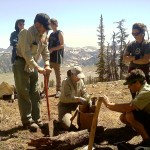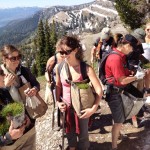2012 Planting at Grand Targhee, Teton Village, Bridger Bowl ski Resorts, & Hill Creek RX Burn Area
Project: Planting at Grand Targhee, Teton Village, Bridger Bowl Resort Areas, and Hill Creek RX Burn Area.
Agency/Forest or Park/District: Grand Targhee Resort, Teton Basin R.Dand Keg Springs Burn area, Ashton/Island Park R.D., Caribou-Targhee N.F., Teton Village Resort, Jackson R.D., Bridger-Teton N.F., Bridger Bowl Resort, Bozeman R.D., Gallatin N.F., Greater Yellowstone Area
Project coordinator: Cathey Hardin (retired), Avery Beyer
Contact: Cathey Hardin (retired). Avery Beyer, abeyer@fs.fed.us, (208) 354-6624
Cooperators
Grand Targhee Resort, Teton Village Resort, Bridger Bowl Ski Resort, Non-Profit Groups, Local Volunteers
Source of funding /amount
FHP: $13,688
Supplemental funding: $35,037 from FS, Arbor Day, TreeFight
Dates of restoration efforts
Summer 2012
Objectives
As outlined in the Whitebark Pine Strategy for the Greater Yellowstone Area (WBPS) planting of whitebark pine is an objective to maintain and restore whitebark pine and to augment national regeneration through planting (pgs. 8-9, 20). The Strategy was prepared in response to the current situation of whitebark ecosystems in the Greater Yellowstone Area (GYA). Many of the WBP has been lost to blister rust, mountain pine beetle and encroachment from other conifers. Planting will restore WBP back on these landscapes with high overstory mortality from these agents.
One strategic objective of the WBPS is to increase knowledge of the ecosystem services provided by mature whitebark pine (pg. 8). This planting project would help to share knowledge about restoration and the importance of whitebark pine in these areas through education and interpretation. Both Grand Targhee Resort and Teton Village Resort are active partners with the US Forest Service and Whitebark Pine Ecosystem Foundation in promoting and assisting in the development of best practices for whitebark pine management. Grand Targhee provides a web page, Nature Center and helps provide a Naturalist on site in providing education to the public on the importance of whitebark pine ecosystems. Bridger Bowl has an active participatory vegetation management program with the Gallatin National Forest and is interested in replacing WBP that been killed by insects and disease
Acres/ha treated
Total of 7M WBP seedlings. Grand Targhee Resort-500, Teton Village Resort-1,000, Bridger Bowl Resort- 750 and Keg Springs Burn Area-4,450, WBP containerized 2.0 seedlings.
Methods
Seedling would be summer planted in the Grand Targhee Resort Area (approximately 500-800 seedlings), Teton Village Resort (800-1,500 seedlings), Bridger Bowl Ski Area (500-1,000 seedlings) and Hill Creek Prescribed Burn Area (approximately 3,700-5,200 seedlings).
Planting in resort areas will be accomplished with local Volunteer Groups, Resort Employees, and Forest Service personnel.
Tree care and planting techniques as outlined in the FS Handbook and specific whitebark pine planting guidelines (McCaughey, Scott, Izlar) will be followed. FS personnel will be on site to assure good planting practices are followed.
Within the Hill Creek Prescribed Burn area, the existing WBP was not burned; conifers were cut and pulled back from the mature WBP trees. There is excellent site prep to plant WBP in an area that once had WBP but was lost to encroachment, blister rust or mountain pine beetle.
Planting operation in Hill Creek will be accomplished by a contractor. A contract is in place through the Shoshone National Forest. A task order will be issued to perform the work. With a contract in place and contractor identified we will be able to work with the same contractor who has planted WBP seedlings on the Forest for the past two years. This is an advantage in communicating contract specifications and overall administration of the contract.
Forest Service personnel will be onsite at all times during the planting operation to assure compliance with contract specifications in all aspects of the planting operation. Spacing will be varied to take advantage of the best micro-sites. Only those areas providing sufficient protection for the seedlings will be planted
Planting? If so, source of seedlings? Resistance?
Yes. Seedlings to be planted were grown from seed which was collected from the 110 seed study source completed by Mary Frances Mahalovich and Coeur d‟Alene nursery. This study (Mahalovich, 2006) provides a relative ranking of the seed sources by rust resistance, cold hardiness and height growth. Seedlings are being grown as 91‟s (6.0” depth, 7.5 cubic inches) a caliper of 2.5+mm is the goal for this stock.
Outcome
The projects were completed and the funds were used. We were hoping to use 4.5M of the seedlings in Hill Creek but because of waiting for trees to be felled to provide microsites and the quickly drying conditions on selected planting site (south slope) I decided to plant the seedlings in the Keg Springs burned area on a north slope with better planting conditions. WBP seedlings have been ordered for planting of the Hill Creek Burn area in 2014.
Ski areas were planted with many different groups and overall the result was good. Always a challenge working with volunteers and it takes many trained personnel to work with individuals to assure trees are planted properly. As with any planting you have to be flexible because of weather conflicts. With planting you have to be adaptable to the conditions as they occur, picking the best site for the WBP seedlings.
Monitoring since completion of the project
Dates
First year survival surveys of the Keg Springs planting area show an approx. 88% survival rate.
Plans for future monitoring?
Follow up surveys will be performed in the summer of 2015 and 2017.
Will outcome meet goals?
Yes. Whitebark pine seedlings are successfully established in areas where they had previously been either eliminated or were in serious decline.
Miscellaneous comments
Being flexible is always needed when weather delays are encountered. Expect slow progress when working with volunteers especially with tree planting.


